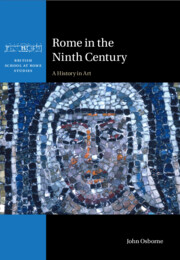Book contents
- Rome in the Ninth Century
- British School at Rome Studies
- Rome in the Ninth Century
- Copyright page
- Contents
- Figures
- Acknowledgements
- Abbreviations
- Ninth-century Popes
- 1 Introduction
- 2 Rome in 800: The Pontificate of Leo III
- 3 Paschal I, the Church of Santa Prassede and the Question of a ‘Carolingian Renovatio’ in Rome
- 4 Paschal I: Other Projects
- 5 Eugenius II, Gregory IV and Sergius II
- 6 The Gathering Storm: The Pontificate of Pope Leo IV (847–55)
- 7 Benedict III, Nicholas I and Hadrian II, and the Continuing ‘Greek’ Presence in Rome
- 8 The Last Hurrah: John VIII (872–82)
- 9 ‘Not with a Bang but a Whimper’
- Afterword
- Bibliography
- Index
6 - The Gathering Storm: The Pontificate of Pope Leo IV (847–55)
Published online by Cambridge University Press: 10 October 2023
- Rome in the Ninth Century
- British School at Rome Studies
- Rome in the Ninth Century
- Copyright page
- Contents
- Figures
- Acknowledgements
- Abbreviations
- Ninth-century Popes
- 1 Introduction
- 2 Rome in 800: The Pontificate of Leo III
- 3 Paschal I, the Church of Santa Prassede and the Question of a ‘Carolingian Renovatio’ in Rome
- 4 Paschal I: Other Projects
- 5 Eugenius II, Gregory IV and Sergius II
- 6 The Gathering Storm: The Pontificate of Pope Leo IV (847–55)
- 7 Benedict III, Nicholas I and Hadrian II, and the Continuing ‘Greek’ Presence in Rome
- 8 The Last Hurrah: John VIII (872–82)
- 9 ‘Not with a Bang but a Whimper’
- Afterword
- Bibliography
- Index
Summary
The shock occasioned by the Arab sack of Saint Peter’s and San Paolo fuori le mura in August 846 serves as the backdrop for the unprecedented building activities of Pope Leo IV (847–855), best known for his construction of fortifications to enclose the entire area around Saint Peter’s in what subsequently came to be known as the ‘Leonine city’. This was the only extension ever made to Rome’s Aurelian walls of the late third century. Considerable resources were also expended on making good the losses of gold and silver liturgical vessels, silk textiles and other furnishings. New church projects included Santi Quattro Coronati and Santa Maria Nova. Also dating from his reign, and signalling a shift in patronage to become more evident in the years to follow, is a subsidiary chapel in the excavated lower church of San Clemente, which includes the pope’s portrait. Consideration is given to the rationale for the installation of this chapel, possibly with a relic from the site of Christ’s Ascension prominently displayed above its altar.
Keywords
- Type
- Chapter
- Information
- Rome in the Ninth CenturyA History in Art, pp. 131 - 160Publisher: Cambridge University PressPrint publication year: 2023

